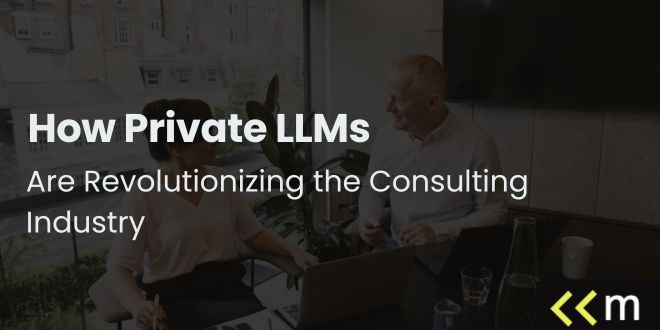How Private LLMs Are Revolutionizing the Consulting Industry

Private LLMs are the quiet power tools consultants always wanted but could never wheel into a client’s boardroom without a stack of NDAs and a nervous glance from legal.
A Custom Large Language Model that is trained or tuned for one company, then sealed inside a secure environment, changes the social contract of consulting.
It lets teams reason over confidential data without letting it wander, and it leaves a clear trail that shows why the system wrote what it wrote.
Instead of hoping that innovation and compliance can share a calendar, teams get both, on purpose.
The result feels a little like upgrading from a pocketknife to a toolkit: the work gets safer, faster, and frankly more interesting.
What Makes Private Models Different
A private model is not just “the same thing, but behind a firewall.” It is a system designed for isolation, reproducibility, and audit.
The model runs in a controlled enclave, often inside a client’s virtual private cloud or on trusted on-prem hardware, with encryption at rest and in transit. Access follows roles, so sensitive corners stay walled off.
Every prompt, file touch, and output is logged. That paper trail is not busywork.
It lets partners sign their name under the work with confidence, since they can show how an answer was assembled step by step. At the heart of the difference is adaptation. The base model knows the general language. The private layer teaches the client’s taxonomy, acronyms, and policies, so the system speaks the organization’s dialect.
Retrieval makes the magic safe: the model reads source documents on demand rather than memorizing them, so sensitive knowledge does not leak into the weights.
That means confidentiality survives upgrades, migrations, and even vendor changes. When the model improves, the secrets do not hitch a ride.
The New Consulting Stack
Think of the modern consulting stack as a tidy set of layers. At the bottom sits secure proprietary data plumbing that knows where truth lives and who can touch it.
Above that, retrieval pulls only what is needed when it is needed.
Then comes prompt orchestration that mirrors real project workflows instead of a pile of ad hoc chats.
On top sits governance that proves you did all of this the right way. The stack is boring by design, and that is a compliment. Boring stacks are dependable, and dependable stacks make ambitious work feel pleasantly routine.
Retrieval With Guardrails
Retrieval is the difference between a clever chatbot and a colleague who has actually read the hundred-page policy memo. Private systems index structured and unstructured sources, attach metadata such as sensitivity labels and lineage, and resolve conflicts when two documents disagree. Citations are not decoration.
They are the reason a skeptical CFO keeps reading, since each sentence can point back to a paragraph, a page, or a row in a data table. When the model cannot find a reliable source, it says so. That simple honesty buys trust you cannot fake.
Where They Change the Work
Private models do not replace consultants. They replace the unglamorous hours that keep consultants from the hard parts, which is where the value has always lived. The change shows up in discovery, proposals, delivery, and quality assurance. Think fewer scavenger hunts and more conversations about tradeoffs.
Discovery And Proposals
Discovery meetings should start with sharp questions, not with “send us everything.” Private systems triage sprawling document sets in minutes. They cluster themes, extract obligations and constraints, and surface contradictions that deserve a human conversation. The result is a map that shows where to dig, not a mountain that buries the team. Proposals benefit in the same spirit.
Drafts respect the client’s tone, procurement rules, and forbidden phrases. Deliverables line up with measurable outcomes, and dependencies stop hiding until week eight. Reviewers spend their time on judgment, not on moving commas or chasing missing definitions. Fewer words, clearer promises, better odds.
Delivery And Quality Assurance
During delivery, the same foundations that protect data also make repeatability possible. Analysts work inside sealed workspaces tied to a versioned knowledge base. Reusable logic gets promoted like any other asset. Two clients can get tailored solutions built from the same well-tested core, which used to be wishful thinking.
Quality assurance moves upstream instead of lurking at the end. Suites of tests check prompts, validate schema, and keep a watchlist of known pitfalls. If the model forgets that a quarter can be fiscal or calendar, the test suite catches it and triggers a tidy fix. The human reviewers focus on judgment and nuance while the system polices the boring but crucial details.
Talent And Team Structure
These tools change what great looks like. The best juniors are not the fastest spreadsheet jockeys. They are the clearest thinkers who can tell a model exactly what to do and how to prove it. Mid-level consultants become editors and directors who shape the work rather than drown in it. Partners gain more surface area with clients, because they can spin up validated explorations instead of waiting for a team to return with a first cut.
The cultural shift is subtle but real. Teams stop guarding knowledge like dragon treasure and start packaging it as reusable components. Credit flows to the people who define patterns, not only to the ones who pull heroic late nights.
Training changes too. Onboarding includes client-specific lexicons, prompt hygiene, and model evaluation basics, so the team shares a crisp language for human-computer collaboration. The vibe moves from frantic to focused, which is far easier to sustain.
Economics That Finally Align
For years, the hourly model quietly fought the efficiency everyone claimed to want. Private models make efficiency too obvious to ignore. When a scoping exercise drops from three weeks to three days, it feels odd to price it the old way. Firms move toward deliverable-based fees, subscriptions for ongoing insights, and shared upside when a recommendation pays off.
The economics reward accuracy, speed, and continuous learning rather than sheer hours worked, which is as refreshing as it sounds. Costs get clearer too. Compute, storage, evaluations, and drift monitoring show up as platform expenses rather than surprises buried in every project. Investments in testing, caching, and hardware start to show up on margin statements.
A partner who knows their unit economics can defend a premium with a straight face, because they can show how the platform reduces risk and improves outcomes. Clients are happy to pay for confidence when it comes with receipts.
Risk, Compliance, and the Boring but Vital Bits
Some readers are nodding along and frowning at the same time. What about misuse, bias, or accidental leakage? Private deployments make those worries manageable. Role-based access keeps sensitive corners walled off. Synthetic test suites stress the system with edge cases, then document the results in language a regulator will understand. Data retention policies turn into code that forgets on a schedule.
If a client wants a clean room that never touches the public cloud, that can be arranged without drama, and with documentation that stands up in an audit. Explainability improves too. True, neural nets are famously opaque at the neuron level. Yet at the system level, private models can produce crisp traces.
They can show the exact sources pulled for a paragraph, the chain of prompts and tools invoked, and the validations that passed before an answer was allowed to appear. When something goes wrong, the team fixes the step, not the entire universe. It is accountability that you can read line by line.
What To Watch Next
Three trends deserve attention. First, vertical models that speak a domain’s dialect will continue to outpace generic systems. They will not just know terms. They will know the shape of problems and the traps to avoid, which cuts rework dramatically. Second, contract-ready governance will move from nice-to-have to table stakes, because vendor questionnaires will keep asking for concrete controls rather than good intentions.
Third, human-computer collaboration will get more tangible, with sessions that look like a pair of analysts working together, one human and one model, both accountable and both visible. None of this is magic. It is just good engineering and good habits pointed at the right problems.
Conclusion
Private LLMs will not turn consultants into spectators. They will make the best consultants easier to find and the worst habits harder to hide. The firms that benefit will be the ones that embrace secure workflows, invest in testing, and teach their teams to think in systems rather than one-off slides.
Clients (especially those in public companies) will feel the difference in the first week of an engagement: fewer status meetings, clearer drafts, and recommendations that trace to the source. In a market that runs on trust, that combination is the ballgame.
Samuel Edwards is an accomplished marketing leader serving as Chief Marketing Officer at LLM.co. With over nine years of experience as a digital marketing strategist and CMO, he brings deep expertise in organic and paid search marketing, data analytics, brand strategy, and performance-driven campaigns. At LLM.co, Samuel oversees all facets of marketing—including brand strategy, demand generation, digital advertising, SEO, content, and public relations. He builds and leads cross-functional teams to align product positioning with market demand, ensuring clear messaging and growth within AI-driven language model solutions. His approach combines technical rigor with creative storytelling to cultivate brand trust and accelerate pipeline velocity.







